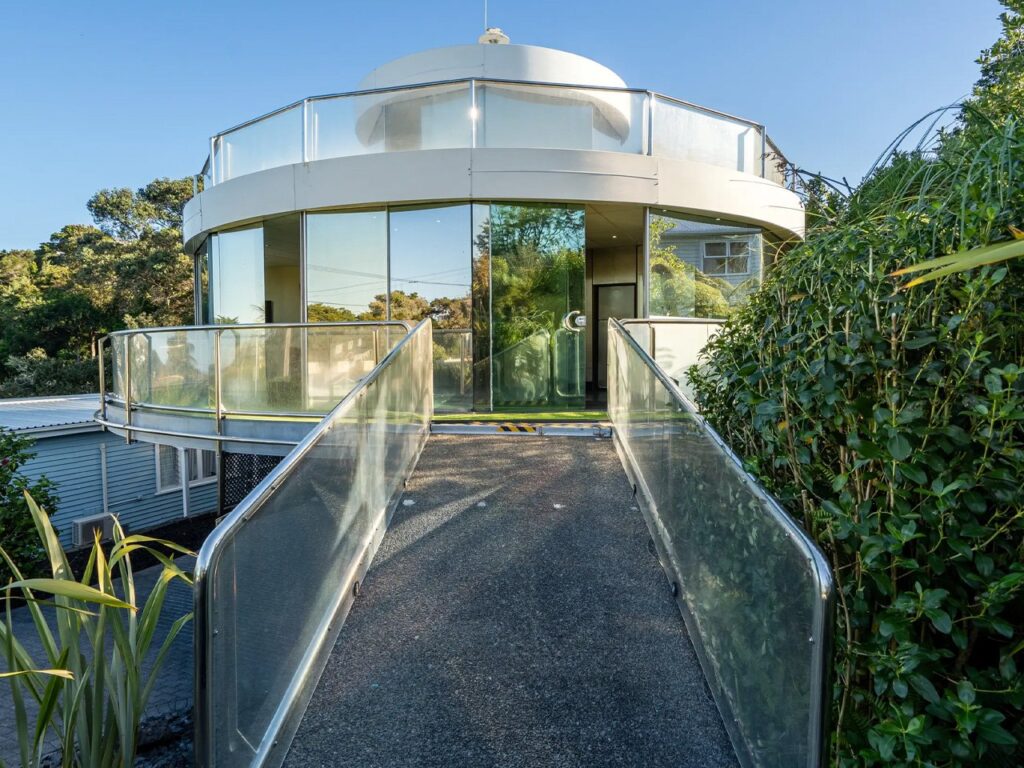
The concept of a home that rotates a full 360 degrees, offering an ever-changing perspective on the world outside, may sound like something out of a science fiction novel. However, innovations in architecture and engineering have made such homes not only possible but also practical. One of the most compelling examples of this is the Circular Glass House, a rotating home that redefines modern living by blending functionality, sustainability, and cutting-edge design.
A Visionary Concept
The idea of a rotating house is rooted in a desire to harmonize architecture with the natural environment. Traditional homes are static, offering fixed views and limited interaction with sunlight or natural breezes. A rotating house, however, takes these limitations and transforms them into opportunities. By continuously rotating, the Circular Glass House ensures optimal sunlight, cross-ventilation, and dynamic views, creating a living space that adapts to its surroundings.
The Circular Glass House: Key Features
Panoramic Glass Design
The house’s cylindrical structure is made almost entirely of glass, offering unobstructed, 360-degree views of the surrounding environment. Whether nestled in a forest, perched on a cliffside, or located in a bustling urban area, the house allows its occupants to feel immersed in their surroundings.
The use of glass not only enhances aesthetics but also promotes a sense of openness and connection to nature. Advanced glass technologies, such as double-glazing and UV coatings, ensure energy efficiency and privacy despite the extensive use of transparent materials.
Continuous Rotation Mechanism
The most remarkable feature of the Circular Glass House is its ability to rotate continuously. Powered by a state-of-the-art motorized hub, the house can complete a full 360-degree rotation in as little as one hour or as long as 24 hours, depending on the desired speed.
This rotation is not just a gimmick—it’s a practical solution to challenges like uneven sunlight distribution and limited views. By rotating, the house ensures that all areas receive equal exposure to natural light, reducing the need for artificial lighting during the day.
Adaptable Living Spaces
Inside the house, the circular layout is carefully designed to maximize functionality. Rooms are arranged around a central core, which typically houses essential systems like plumbing, electricity, and HVAC. The fluidity of the design allows for flexible use of space, making the home highly adaptable to the changing needs of its occupants.
Furniture and interior elements are secured in place to prevent movement during rotation, ensuring a seamless living experience.
Engineering Marvels
Rotational Hub and Bearings
At the heart of the Circular Glass House’s rotation is a sophisticated hub-and-bearing system. The house is elevated slightly off the ground, resting on a platform equipped with heavy-duty bearings. This setup allows the entire structure to rotate effortlessly with minimal friction.
The hub is powered by electric motors that can be programmed for continuous or on-demand rotation. Smart technology enables homeowners to control the speed and direction of rotation using a smartphone app or home automation system.
Structural Stability
Despite its unique design, the Circular Glass House is built to withstand the elements. The cylindrical shape provides inherent structural stability, while the rotating platform is engineered to distribute weight evenly. Advanced materials, such as reinforced steel and tempered glass, ensure durability and safety.
Energy Efficiency
Sustainability is a cornerstone of the Circular Glass House. The ability to control exposure to sunlight reduces reliance on artificial heating, cooling, and lighting. Solar panels integrated into the roof or surrounding landscape can provide renewable energy to power the house, including its rotation mechanism.
Benefits of Rotating Homes
Maximizing Views
For homeowners, one of the most exciting features of a rotating house is the ability to enjoy ever-changing views. Whether it’s the sunrise, sunset, or a stunning mountain range, the Circular Glass House ensures that no vista is ever out of reach.
Optimizing Natural Light
The continuous rotation allows the house to track the sun’s movement, ensuring optimal natural light throughout the day. This not only enhances the living experience but also reduces energy consumption.
Improved Ventilation
By rotating, the house can harness natural breezes more effectively, improving ventilation and indoor air quality. This is particularly beneficial in warmer climates, where cross-ventilation can reduce the need for air conditioning.
Unique Living Experience
Living in a rotating home offers a sense of novelty and excitement. It challenges conventional ideas of what a house can be, making daily life feel more dynamic and engaging.
Maintenance
The mechanical components of the rotation mechanism require regular maintenance to ensure smooth operation. Homeowners must be prepared for additional upkeep compared to a standard house.
Location
The success of a rotating house largely depends on its location. To fully enjoy its features, the house needs to be situated in an area with stunning views and minimal obstructions.
Energy Usage
While the Circular Glass House is designed to be energy-efficient, the motorized rotation mechanism does consume electricity. Sustainable energy sources, such as solar panels, are essential to offset this consumption.
The Circular Glass House in Context
The Circular Glass House represents a broader trend in architecture toward creating dynamic, adaptable living spaces. As cities grow denser and natural resources become scarcer, architects are exploring innovative ways to integrate sustainability and functionality into their designs.
Rotating homes like the Circular Glass House challenge the static nature of traditional architecture, offering a glimpse into a future where homes are more in tune with their environment and the needs of their occupants.
Cultural and Environmental Implications
Rotating homes also have cultural significance, representing a shift in how we view our relationship with space and nature. They encourage us to think beyond the boundaries of conventional living and consider how our homes can enhance our connection to the world around us.
Environmentally, rotating homes promote sustainable living by optimizing natural resources like sunlight and wind. They serve as a model for how architecture can adapt to climate change and the growing demand for energy-efficient solutions.
Impression
The Circular Glass House is more than a home—it’s a statement about the possibilities of modern architecture. By combining innovative design, advanced engineering, and a deep respect for nature, it offers a living experience that is as functional as it is awe-inspiring.
For those who seek to break free from the constraints of traditional housing, the Circular Glass House provides a glimpse into a future where homes are as dynamic and adaptable as the people who live in them. As technology continues to advance, the dream of living in a rotating house may become an accessible reality for many, forever changing the way we think about home.
https://youtu.be/-rsbQm4hRCM?si=5dhlB1NxZE4yQBtm
No comments yet.








